Transformational Gardening
June 2009 Foraging Experiences
(Back to:
May 2009 Foraging Experiences)
(Forward to:
July 2009 Foraging Experiences)
June 20, 2009
On the hunt for
Eastern White Pine (Pinus strobus) to make Pine Needle Tea.
Pine Needle Tea has a large amount of Vitamin C. The tea was sometimes brewed
with both the pine needles and pine twigs or bark. The bark contains significant
quantities of bioflavanoids that enhance the function of Vitamin C.
From what I have read, pine needle tea can be made out of the needles of any pine tree,
but I looked for Eastern White Pine today. I will compile a web site with more information
about
Eastern White Pine identification, where is can be found in the U.S., and
medicinal / food uses.
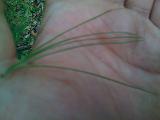 According to the
Peterson Field Guide for Eastern Trees (North America), Eastern White Pine is the only native pine tree
that has 5 needles per cluster. This should make it easy to identify ... even for someone like me who has a
difficult time telling a pine tree from a palm tree!
According to the
Peterson Field Guide for Eastern Trees (North America), Eastern White Pine is the only native pine tree
that has 5 needles per cluster. This should make it easy to identify ... even for someone like me who has a
difficult time telling a pine tree from a palm tree!
Most of the large pine trees that I encountered today had no branches below 30 feet, so I couldn't
tell if they were Eastern White Pines. I speculated that the lower branches on these pines
weren't growing because the forest was packed tightly with deciduous trees that blocked the sunlight
and prevented the lower pine leaves from growing. But I was able to find smaller white pine trees:
 |
Came home with a few small bags of pine needles. I was careful to not pull off too many pine needles
from any one tree (to avoid damaging the tree). The directions I read online suggested to use one
“handful” of pine needles per cup of water. Washed two handfuls of needles and then
chopped them. I boiled one pint of water and poured the water over the chopped needles, covered and
let steep for 30 minutes.
After a short wait, I had a supply of Pine Needle Tea for the weekend.
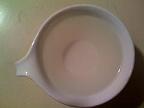 |
It is pine-tasting. Something that I wouldn't think I'd enjoy, but I liked it. It might go better
with a little bit of honey. It is very easy to collect the pine needles brew the tea, so I'll try
it again soon.
Contraindications: Do not drink pine needle/twig/bark tea when pregnant or if you are allergic to pine.
June 28, 2009
This afternoon, I went foraging for
Common
Dandelion (Taraxacum officinale),
Pitch Pine (Pinus rigida), and
Eastern White Pine (Pinus strobus).
Dandelion is one of the most nutritious and healing plants available. Dandelion greens are a very good
source of:
- Calcium (140 mg per 100 grams (3.5 ounces))
- Iron (1.8 mg per 100 grams (3.5 ounces))
- Potassium (232 mg per 100 grams (3.5 ounces))
- Vitamin A (14544 IU per 100 grams (3.5 ounces))
- Vitamin K (359 mcg per 100 grams (3.5 ounces))
- Lutein (an antioxidant important for healthy vision) (3398 mcg per 100 grams (3.5 ounces))
Dandelion root tea is one of the most powerful liver and blood cleansers in Herbal Medicine.
It treats hepatitis, cirrhosis, gallstones, skin problems, infections, carious teeth, swollen,
red or painful eyes, and fever. It strengthens the digestive system. It is a valuable herb for
treating diabetes and hypoglycemia. Dandelion roots can be roasted and ground into a coffee
substitute. I will compile a web site with more information about
Dandelion identification, where it can be found in the U.S., and its medicinal / food uses
It is funny how people spend so much time and effort trying to erradicate dandelions from their lawns
rather than letting it grow and harvesting it from their own yard! My local co-operative market was
selling a bunch of dandelion greens for $2.99, but from nature it is free if you can find it.
Since most backyards and city parks are treated with toxic fertilizers and toxic pesticides, I went
to the state park to try and find dandelion. I didn't see it on the forest trails while collecting
pine needles. Even in the fields at the state park I didn't see any dandelions. When I'm not foraging
for them, they seem to be everywhere!
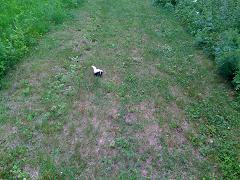
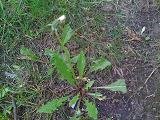 I usually see dandelion in grassy fields, so I stopped by another park and found a little.
Most of the typical yellow flowers had gone to seed and closed up. The picture on the right shows
a typical dandelion with easily-recognizable, toothy leaves. As you can see from the second picture on the right,
I almost walked right on top of a skunk while my head was down looking for dandelions!
I usually see dandelion in grassy fields, so I stopped by another park and found a little.
Most of the typical yellow flowers had gone to seed and closed up. The picture on the right shows
a typical dandelion with easily-recognizable, toothy leaves. As you can see from the second picture on the right,
I almost walked right on top of a skunk while my head was down looking for dandelions!
The
Peterson Field Guide for Edible Wild Plants of Eastern/Central North America suggests
that the best time to eat the leaves is in the early Spring, the flowers can be gathered
for food from the Spring to the early Summer and the roots can be gathered for tea, food
or coffee substitute from the Fall to the Early Spring. In the book,
The Forager”s Harvest: A Guide to Identifying, Harvesting, and Preparing Edible
Wild Plants, Samuel Thayer has this to say about dandelion:
...so many who teach about wild plants have chosen to emphasize ubiquitous but
mediocre edibles such as dandelion and common plantain. Dandelion is a bitter
green that nearly everybody dislikes on the first try, and I can find nothing
positive to say about the flavor or texture of plantain greens. If someone is
introduced to wild foods via these plants I cannot blame him for thinking that we
neo-primitive food gathers are force-feeding ourselves for the sake of having a
hobby.
Even the less bitter Springtime dandelion leaves I disliked on the first try, but
I tend to like them now. The same was true about pine needle tea -- I was not crazy
about it the first time I tried it, but now, with a little honey and mint added,
I like it quite a bit. For me, dandelion root tea does not taste bitter (with a
little honey or licorice root added). Dandelion greens are so nutritious, I consider
eating them like taking a powerful medicine. But what is more important is that
since I don't have a foraging guide at my side all of the time, I felt it was
important to start out with extremely easy-to-recognize and common plants and then
gradually move on to other plants.
I gathered a few small leaves, washed them and simmered for approximately 10 minutes
and ended up with an infant-sized portion of dandelion greens!
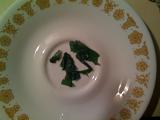 |
If there was one place in the state I would expect to find pitch pine trees, it would be on
"Pitch Pine Trail" in the local park. There were countless trees that I think were cedars and
numerous young eastern white pines. But I couldn't find a single pitch pine tree on that trail!
Aparently, the pitch pine has 3 needles per bundle and 1/2-inch branches that are fiberous and do not
break cleanly when bent. Where did the pitch pine trees run off to?
The most common tree along the Pitch Pine Trail is one I'd like to identify. It looks like an
American Beech tree (Fagus grandifolia), but I'm not sure. (See pictures and description
of the Beech tree towards the end of the article
Ten Tree Species on the NH Botanical web site.) It looks like most trees in that park were missing
their nametag.
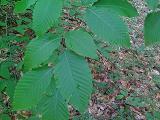 |
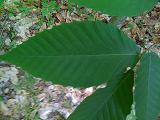 |
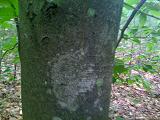 |
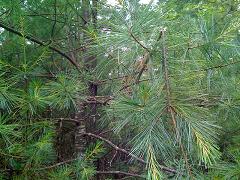 I started loving the taste of chilled Pine Needle Tea (with honey), but ran out of pine
needles. So, while hunting for Pitch Pine, I encountered hundreds of young
Eastern White Pine along the trail. Having read about traditional uses of pine tree
twigs as part of pine needle tea, I decided to collect them as well. But I was careful
to collect just a small amount of needles from each tree and I only gathered twigs that
were already broken off (just hanging by a thread).
I started loving the taste of chilled Pine Needle Tea (with honey), but ran out of pine
needles. So, while hunting for Pitch Pine, I encountered hundreds of young
Eastern White Pine along the trail. Having read about traditional uses of pine tree
twigs as part of pine needle tea, I decided to collect them as well. But I was careful
to collect just a small amount of needles from each tree and I only gathered twigs that
were already broken off (just hanging by a thread).
Recipe:
- Two handfuls of pine needles and some twigs (washed and chopped)
- 3 big mint leaves (chopped)
- honey to taste
- 4 cups of spring water
Boil the water. Turn off the water. Add washed and chopped pine needles, twigs and mint leaves.
Let steep for 15-30 minutes (or longer). Strain off leaves. Add honey to taste. Refrigerate.
Yummy!
Pine needles and pine bark seem to be revered in eastern tradition for longevity and health-giving
properties. One page 25 of
The Eyes of Power by Karen Gerhart, the author states:
The most popular meaning of the pine tree in China and Japan is that of longevity. Most sources
simply state that the association of the pine tree with long life is related to the fact that the tree
remains green year-round, signifying continuing life. This idea, however, was likely further grounded in
ancient Chinese alchemy and its concerns with promoting human longevity and immortality. Of the various
elixirs and medicines, plant-produced drugs were noted for quick results, while those produced from
minerals were seen as slower but more powerful. Of the plant elixirs, those made from pine trees were among
the most popular. Pine needles, roots, and resin were all used by the Chinese in potions believed to
prolong life. The resin, in particular, was considered an important element in the human diet in order to
render the body light and to prevent the onset of old age. Therefore, in addition to the tree's physical
durability, the medicinal, preservative properties of the pine certainly made it an appropriate symbol of
longevity; humans who drank of the elixir were believed to become immortal.
On Page 12 of
A Hermit's Pharmacopia by Frederick Dannaway, the author describes what were believed by the Chinese
to be health-giving, longevity and even magical properties of pine.
Contraindications: Do not drink pine needle/twig/bark tea when pregnant or if you are allergic to pine.
June 30, 2009
I added a local images column to the
2009 Foraging Key. You can see local images at different times of the year of the plants or trees being
foraged.
I was walking by a city park today and saw a whole bunch of pine trees. I think they may be
Pitch Pine. Pitch Pine is mentioned for its many medicinal uses throughout
Book One: Aromatics, part of one of the most influencial Materia Medica in Western Herbalism
(written by Dioscorides in the 1st century AD).
According to my two guidebooks for Eastern U.S. trees
(Peterson Field Guide for Eastern Trees;
National Audubon Field Guide to Trees: Eastern Region),
there are only four (4) pine trees native to New Hampshire and three (3) pine trees
that are imported to the Eastern U.S.:
Pines in New Hampshire
| Common Name |
Alternate Names |
Scientific Name |
Native
to NH |
Needles
per Bundle |
| Eastern White Pine |
|
Pinus strobus |
Yes |
5 |
| Pitch Pine |
|
Pinus rigida |
Yes |
3 |
| Red Pine |
Norway Pine |
Pinus resinosa |
Yes |
2 |
| Jack Pine |
Scrub Pine; Gray Pine |
Pinus banksiana |
Yes |
2 |
| Australian Pine |
|
Pinus nigra |
No |
2 |
| Scotch Pine |
|
Pinus sylvestris |
No |
2 |
| Japanese Mountain Pine |
Black Pine |
Pinus thunbergii |
No |
2 |
As you can see from the pictures, these pines had three (3) needles per bundle.
In addition, the Pitch Pine is the only 3 needle per bundle pine that has
“half-inch branches that are fibrous and tough; they do not snap cleanly when bent
sharply.” I tested a half-inch branch and it bent, but did not break. The cones
are 1-3 inches and have thorns. It grows 40-60 feet high. The article
Ten Tree Species on the NH Botanical Society web site states that “The big giveaway
with pitch pine is that it often has needles growing out of the bark along the trunk, making
it look like the unshaven, shaggy cousin of our other pines.” That site also does not
mention Australian Pine nor Japanese Mountain Pine as pines in New Hampshire. They point
out that Red Pine (“Norway Pine”) is “uncommon in southern New Hampshire, being more
common in the Saco River valley of Carroll County and Oxford County in Maine.”
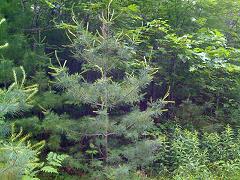
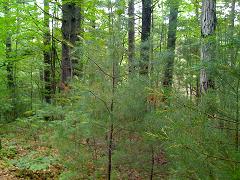
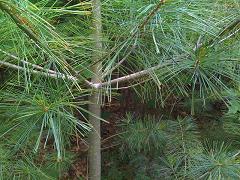
 According to the
Peterson Field Guide for Eastern Trees (North America), Eastern White Pine is the only native pine tree
that has 5 needles per cluster. This should make it easy to identify ... even for someone like me who has a
difficult time telling a pine tree from a palm tree!
According to the
Peterson Field Guide for Eastern Trees (North America), Eastern White Pine is the only native pine tree
that has 5 needles per cluster. This should make it easy to identify ... even for someone like me who has a
difficult time telling a pine tree from a palm tree!





 I usually see dandelion in grassy fields, so I stopped by another park and found a little.
Most of the typical yellow flowers had gone to seed and closed up. The picture on the right shows
a typical dandelion with easily-recognizable, toothy leaves. As you can see from the second picture on the right,
I almost walked right on top of a skunk while my head was down looking for dandelions!
I usually see dandelion in grassy fields, so I stopped by another park and found a little.
Most of the typical yellow flowers had gone to seed and closed up. The picture on the right shows
a typical dandelion with easily-recognizable, toothy leaves. As you can see from the second picture on the right,
I almost walked right on top of a skunk while my head was down looking for dandelions!




 I started loving the taste of chilled Pine Needle Tea (with honey), but ran out of pine
needles. So, while hunting for Pitch Pine, I encountered hundreds of young
Eastern White Pine along the trail. Having read about traditional uses of pine tree
twigs as part of pine needle tea, I decided to collect them as well. But I was careful
to collect just a small amount of needles from each tree and I only gathered twigs that
were already broken off (just hanging by a thread).
I started loving the taste of chilled Pine Needle Tea (with honey), but ran out of pine
needles. So, while hunting for Pitch Pine, I encountered hundreds of young
Eastern White Pine along the trail. Having read about traditional uses of pine tree
twigs as part of pine needle tea, I decided to collect them as well. But I was careful
to collect just a small amount of needles from each tree and I only gathered twigs that
were already broken off (just hanging by a thread).






